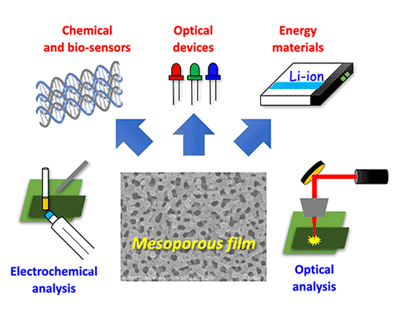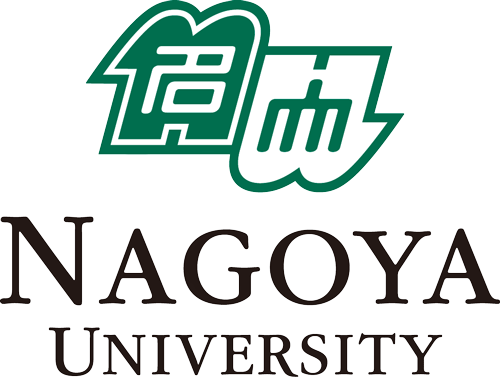In this ERATO, we will create novel “inorganic nanosolids” containing internal nanospaces,as unprecedented nanospace materials, and develop several methodologies for their effective integration with the aim of exploiting functions obtained based on the synergistic fusion of various supramolecular, photonic, and magnetic behaviors occurring in nanospace. We will cover a wide range of various porous systems such as metals, carbons, sulfides, phosphides, transition metal oxides, etc. We will efficiently combine ‘machine learning’ with our inorganic synthesis methods to accelerate the optimization of synthetic parameters for the design of target materials, and to select proper patterns of combination of each inorganic block for the integration of materials.
Research Groups
Various inorganic materials with highly-ordered nanoarchitectures can be prepared using a variety of inorganic building blocks (IBBs) as a component. Especially, carefully designed assembly of several types of IBBs can form new hybrids with unique functions, which is caused by integrating the individual IBBs’ properties. The aim of this tecton is a precise synthesis of IBBs and the subsequent designed assembly for the integration of functions. The synthesized IBBs possess morphological dimensionality and controlled surface nature for the facilitation of their assembly. Each IBBs have controlled physicochemical properties, which lead to significant functions by the assembly. Also, the assembled nanostructured compounds can be utilized as a new IBB to architect hierarchically assembled nanomaterials with multiplicatively integrated functions.
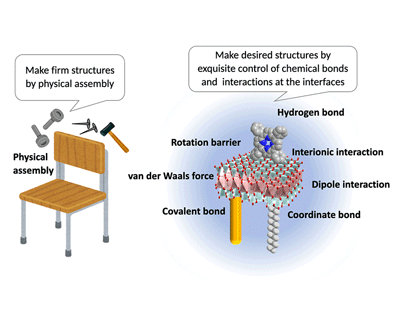
Since nanostructured materials have a large surface area, their properties are strongly influenced by the characteristic physical properties of interfaces and the effects of substances surrounding them. On the scale of our daily life, for example, when we make a chair, we physically assemble the parts using screws or nails so that they do not disintegrate under the influence of gravity. For nano-scale assembly, it is necessary to exquisitely control the balance of small interactions such as hydrogen bonds, van der Waals forces, and bond rotation barriers. Furthermore, these interactions are affected by the surrounding physical environment including temperature and polarity. The place where these various interactions work is the interface between the materials, and it is impossible to universally synthesize various nano-sized materials without understanding and controlling the involved interactions at the interfaces. In other words, interfacial control is an essential technology related to all the "inorganic total synthetic chemistry" and "material space-tectonics" that this project aims to achieve.
Our tecton is responsible for evaluating the physicochemical properties (especially, electrochemical and optical) of newly synthesized nanomaterials and their integrated hybrid materials in the project. The members participating in this tecton are well-versed in electrochemical or optical instrumentation engineering. Therefore, we will be able to analyze and understand electrochemical reactions in nanoarchitectured films and apply these films to sensor devices, optical devices, and energy materials applications by applying our original measurement techniques such as an electrochemical impedance analysis system and newly developed optical system. Finally, we can deeply understand the relationship between nanostructures with various architectures and physicochemical properties through comprehensive characterization.
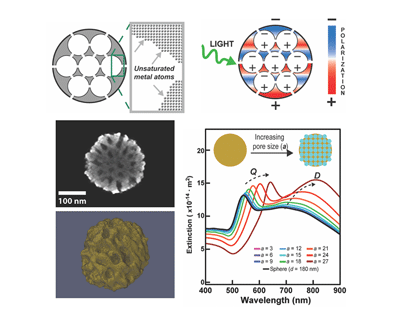
Hierarchical porous materials are a class of composite material containing structural subcomponents organized at smaller length scales. For example, living organisms use hierarchically-organized porous structures to create wood and bone for structural support and mass transport of liquids. The role of these porous subcomponents is to enhance the physical or chemical performances of the material. Inspired by these natural hierarchical materials, we aim to develop metals with hierarchical structuring. Metals are attractive materials because of their significant electronic and optical conductivities as well as their catalytic activity. We will create metal composites that are mixtures of nanoscale and macroscale features that impart some overall property or function (e.g., light absorbance, catalytic properties, enhanced mechanical durability, etc.) that cannot be achieved with the individual features. We will initially focus on hierarchically-structured noble metals because the interaction between light and mesoporous metals be detected optically via the surface plasmon. We will expand the work into catalytic metals and examine photo(electro) catalytic reactions.
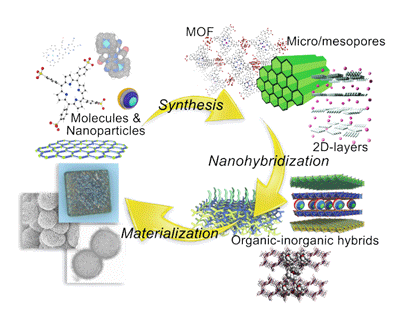
Functional nanomaterials have properties based on the chemical identities of the individual tecton components. The chemical identities of the tectons in turn affect their mechanisms of assembly or reaction to form larger supramolecular or polymeric structures. The resulting nanomaterials thus possess functionalities based on their components, nanostructures, and morphologies. Here we seek to use principles of molecular engineering and design to establish nanoscale materials having unique functionalities based on molecular properties, self-assembly, and hierarchical structure. We will explore functional nanomaterials and their porosity at different dimensions. In particular, porous/3D assemblies will be prepared using chemical self-assembly of supramolecular materials and covalent synthesis of nanostructured polymers. For example, structures and properties of chiral monolithic materials will be examined. Functional molecular materials developed by this group will be applied for the 2D assembly of redox-active molecules, sensing/imaging, photo/electrochemical, and catalytic properties with an emphasis on energy and environmental applications.




